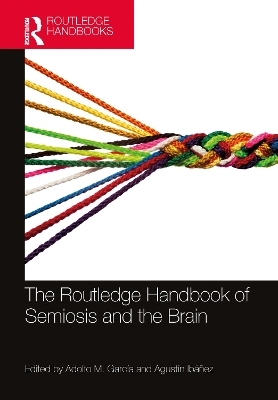
The Routledge Handbook of Semiosis and the Brain
Routledge (Verlag)
978-0-367-50916-3 (ISBN)
This Handbook introduces neurosemiotics, a pluralistic framework to reconsider semiosis as an emergent phenomenon at the interface of biology and culture.
Across individual and interpersonal settings, meaning is influenced by external and internal processes bridging phenomenological and biological dimensions. Yet, each of these dyads has been segregated into discipline-specific topics, with attempts to chart their intersections proving preliminary at best. Bringing together perspectives from world-leading experts, this volume seeks to overcome these disciplinary divides between the social and the natural sciences at both the empirical and theoretical levels. Its various chapters chart the foundations of neurosemiotics; characterize linguistic and interpersonal dynamics as shaped by neurocognitive, bodily, situational, and societal factors; and examine other daily neurosemiotic occurrences driven by faces, music, tools, and even visceral signals.
This comprehensive volume is a state-of the-art resource for students and researchers interested in how humans and other animals construe experience in such fields as cognitive neuroscience, biosemiotics, philosophy of mind, neuropsychology, neurolinguistics, and evolutionary biology.
Adolfo M. García specializes in the neuroscience of language and communication. He serves as Director of the Cognitive Neuroscience Center (UdeSA, Argentina), Senior Atlantic Fellow at the Global Brain Health Institute (UCSF, USA), Associate Researcher at USACH (Chile), Director of Language Science at Redenlab, and Researcher at CONICET (Argentina). Dr. García leads research projects in more than ten countries across the globe. He has more than 200 publications, including works in top ten journals. His scientific contributions have been recognized by various awards and distinctions. Agustín Ibáñez works on global approaches to dementia and social, cognitive, and affective neuroscience. He is Director of the Latin American Brain Health Institute (BrainLat) and Full Professor at the CSCN (Universidad Adolfo Ibáñez, Chile); and Associate Research Professor and Group Leader of Predictive Brain Health Modelling Group (TCD, Ireland). Dr Ibáñez has over 300 publications, including works in top ten journals. His intense work has helped Latin American translational neuroscience by establishing a framework to engage scientists through internships, workshops, master’s and PhD programs, organizing educational activities for the health community, and focusing on cognitive neuroscience, among others.
Acknowledgements
Semiosis, brain, and context: The unmet need for a transdisciplinary framework (A. M. García & A. Ibáñez)
PART 1: PROLEGOMENA TO NEUROSEMIOTICS
1. Neurosemiotics: A brief history of its development and key concerns (K. Kull & D. Favareau)
2. Steps to a semiotic cognitive neuroscience (T. Deacon)
3. An active inference approach to semiotics: A variational theory of signs (A. Milette-Gagnon, S. P. L. Veissière, K. J. Friston, & M. J. D. Ramstead)
4. Experimental semiotics: Past, present, and future (J. Nölle & B. Galantucci)
5. Beyond the human animal: Towards a cross-species neurosemiotics (M. Tønnessen)
PART 2: LANGUAGE AND ITS PATHWAYS TO MEANING
6. Neural bases of multimodal semantics (M. Visser)
7. Embodied mechanisms and the shaping of semantics (G. Buccino)
8. The figurative brain (V. Cuccio)
9. Pharmacological modulation of meaning attribution (E. Tagliazucchi)
10. How grammar means (M. de Vega)
11. Discourse and the brain: Capturing meaning in the wild (N. Riccardi & R. H. Desai)
12. Words, meanings, and the bilingual brain (N. del Maschio, J. Abutalebi, & D. Perani)
13. How do sign languages mean? (R. Campbell)
PART 3: THE NEUROSEMIOTICS OF SOCIAL DYNAMICS
14. Empathy, meaning, and the human brain (K. Lehmann & P. Kanske)
15. Biological bases of moral cognition and their role in the construal of meaning (S. Baez)
16. The neurosemiotics of social interaction: Insights from second-person neuroscience (L. Schilbach)
17. Joint epistemic engineering: The neglected process in human communication (A. Stolk, J. Bašnáková, & I. Toni)
18. Towards a neurosemiotics of friendship (C. Emmeche)
19. Neurosemiotics and ideology: A linguistic view (A. Lukin & D. Butt)
20. The interplay of culture, religion, and biology (J. Y. Sasaki & H. I. Pearson)
PART 4: FURTHER SEMIOTIC DOMAINS
21. What makes us human? Face identity recognition (B. Rossion)
22. Musical signs and the human organism (A. M. Belfi)
23. The meaning of tools: The pragmatic value of semantic knowledge (F. Osiurak, J. Baumard, C. Merck, & M. Lesourd)
24. Interpreting the signals within: Meaning and prediction during interoception (R. Smith & S. S. Khalsa)
25. The hierarchical semantics of self (G. Northoff & D. Gorini)
| Erscheinungsdatum | 26.10.2022 |
|---|---|
| Reihe/Serie | Routledge Handbooks in Linguistics |
| Zusatzinfo | 2 Tables, black and white; 31 Line drawings, black and white; 26 Halftones, black and white; 57 Illustrations, black and white |
| Verlagsort | London |
| Sprache | englisch |
| Maße | 178 x 254 mm |
| Gewicht | 1300 g |
| Themenwelt | Geisteswissenschaften ► Psychologie ► Allgemeine Psychologie |
| Geisteswissenschaften ► Sprach- / Literaturwissenschaft ► Anglistik / Amerikanistik | |
| Geisteswissenschaften ► Sprach- / Literaturwissenschaft ► Literaturwissenschaft | |
| Naturwissenschaften ► Biologie ► Humanbiologie | |
| Naturwissenschaften ► Biologie ► Zoologie | |
| ISBN-10 | 0-367-50916-4 / 0367509164 |
| ISBN-13 | 978-0-367-50916-3 / 9780367509163 |
| Zustand | Neuware |
| Haben Sie eine Frage zum Produkt? |
aus dem Bereich


